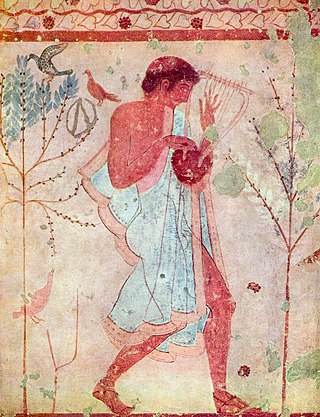
Fidenae was an ancient town of Latium, situated about 8 km north of Rome on the Via Salaria. Its inhabitants were known as Fidenates. As the Tiber was the border between Etruria and Latium, the left-bank settlement of Fidenae represented an extension of Etruscan presence into Latium. The site of the arx of the ancient town was probably on the hill on which lies the contemporary Villa Spada, though no traces of early buildings or defences are to be seen; pre-Roman tombs are in the cliffs to the north. The later village lay at the foot of the hill on the eastern edge of the high-road, and its curia, with a dedicatory inscription to Marcus Aurelius by the Senatus Fidenatium, was excavated in 1889. Remains of other buildings may also be seen.

Falerii is a village in the municipality of Fabrica di Roma in the Province of Viterbo, Italy. Its name is better known for two nearby ancient cities, Falerii Veteres and Falerii Novi.

Lars Tolumnius was the most famous king of the wealthy Etruscan city-state of Veii. He is best remembered for instigating, and decisively losing, a war with the neighboring Roman Republic.
Postumus Aebutius Helva Cornicen was consul at Rome in 442 BC, and magister equitum in 435.
The gens Servilia was a patrician family at ancient Rome. The gens was celebrated during the early ages of the Republic, and the names of few gentes appear more frequently at this period in the consular Fasti. It continued to produce men of influence in the state down to the latest times of the Republic, and even in the imperial period. The first member of the gens who obtained the consulship was Publius Servilius Priscus Structus in 495 BC, and the last of the name who appears in the consular Fasti is Quintus Servilius Silanus, in AD 189, thus occupying a prominent position in the Roman state for nearly seven hundred years.
Marcus Geganius Macerinus was a Roman statesman who served as Consul in 447, 443, and 437 BC, and as Censor in 435 BC.
The Roman–Sabine wars were a series of wars during the early expansion of ancient Rome in central Italy against their northern neighbours, the Sabines. It is commonly accepted that the events pre-dating the Roman Republic in 509 BC are semi-legendary in nature.
Gaius Servilius Ahala was a three time consular tribune of the Roman Republic in 408, 407 and 402 BC. He was also magister equitum in 408 BC.
Gaius Julius Iullus was consul in 447 BC, and again in 435.
Lucius Sergius Fidenas was a Roman politician during the 5th century BC, and was elected consul in 437 and 429 BC. In 433, 424, and 418 BC he was military tribune with consular power.
Publius Servilius Priscus was a Roman senator active in the fifth century BC and consul in 463 BC.
Quintus Servilius Priscus Fidenas was a political figure and military leader in the Roman Republic who served as dictator in 435 BC and in 418 BC.

The Battle of Fidenae was fought in 437 BC between the Roman Republic, led by the dictator Mamercus Aemilius Mamercinus, and the combined forces of Fidenae and Veii, led by Lars Tolumnius.
Lucius Quinctius Cincinnatus was a consular tribune of the Roman republic in 438, 425, 420 BC and possibly consul in 428 BC.
Proculus Verginius Tricostus was a consul of the Roman Republic in 435 BC. He was possibly re-elected as consul in 434 BC.
Titus Quinctius PoenusCincinnatus was a consul of the Roman Republic in 431 and 428 BC and a consular tribune in 426 BC. He might have been consular tribune again in 420 BC.
Hostus Lucretius Tricipitinus was a consul of the Roman republic in 429 BC.
Gaius Servilius Axilla was a Roman aristocrat and statesman during the early Republic. He held the senior executive offices of consul in 427 BC and consular tribune in 419, 418 and 417 BC. He also served as master of the horse, or deputy, to the dictator Quintus Servilius Priscus Fidenas in 418 BC, when the latter had been appointed to wage war against the Aequi.
Marcus Papirius Mugillanus was a consular tribune in 418 and 416 BC, and perhaps consul of the Roman Republic in 411.
Quintus Servilius Fidenas was a prominent early Roman politician who achieved the position of Consular tribune six times throughout a sixteen-year period. Quintus Servilius was a member of the illustrious gens Servilia, a patrician family which had achieved great prominence since the foundation of the republic. In particular, Servilius was the son of Quintus Servilius Priscus Fidenas, a well respected statesman and general who served as dictator twice, in 435 and 418 BC, as well as holding the religious title of either augur or pontifex, which he held until his death in 390 BC. Servilius the younger himself had at least one son, also named Quintus Servilius Fidenas, who served as consular tribune in 382, 378, and 369 BC.




